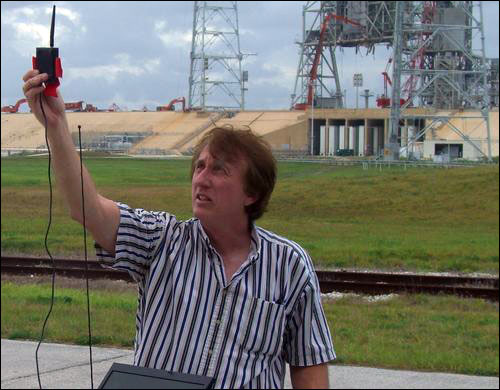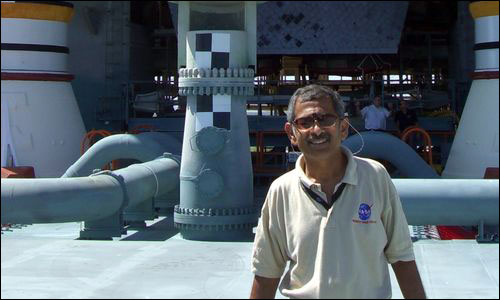The National Aeronautics and Space Administration (NASA) is employing radio frequency identification to capture data regarding vibration, as well as gauge the acoustic emissions that cause that vibration, during space shuttle and rocket launches at Florida’s Kennedy Space Center (KSC) and Cape Canaveral Air Force Station, located at Patrick Air Force Base. The solution, provided by wireless sensor company MicroStrain, consists of active 2.4 GHz RFID tags with built-in sensors that capture the vibrations resulting at different areas surrounding a launch pad during liftoff. NASA can use that data to gain greater understanding of the sound waves emitted from launches, and better predict any potential damage that sound waves might cause to equipment and structures within the area. In the future, the space agency may also place tags with strain sensors on fuel containers, or on the treads of giant tractors known as crawler transporters that move rockets to a launch pad.
NASA aerospace engineers Rudy Werlink and Ravi Margasahayam first tested the wireless system earlier this year, when space shuttles were launched for the last time at Kennedy Space Center, though the two men continue to utilize the system at Cape Canaveral, where U.S. Department of Defense rocket launches are regularly scheduled.
For decades, NASA has been monitoring the levels of sound, vibration and accumulated stress that can result from rocket launches. The sound from rocket exhaust as it mixes with ambient air can be difficult to predict, Margasahayam explains, and the amount of strain that the resulting vibration places on nearby structures can accumulate to the point that damage can potentially occur. “The idea is to make the ground equipment and structures safe, reliable and operational,” he says. However, the large quantity of structures and equipment, spread out across many acres of land, make this a difficult endeavor.
Researchers can not be present themselves for testing, since liftoff can be hazardous. Thus, sensors must be used. NASA engineers are limited as to where they can mount the sensors, especially in the case of wired sensors. “We can’t put sensors every place we want,” Margasahayam says. For one thing, he notes, wires can be damaged due to the extreme conditions of a rocket launch. In addition, long wire runs can affect data quality. The Florida launching sites pose not only mechanical hazards, from the launches themselves), but also environmental. Wires attached to camera equipment used by members of the press, for example, have been attacked by alligators.
With the wireless MicroStrain solution, the sensors could be placed practically anywhere, to then transmit information to a data-collection base station within a building that has a good line of sight to the sensors, in order to maximize the system’s read range. Although each sensor has a built-in battery, the engineers chose to link the tag to additional batteries, via a short wire, to increase its service life. A reader wired to a PC loaded with MicroStrain software can collect and store that information. The data can also be forwarded to a Web-based server known as SensorCloud, via an Ethernet connection—though NASA is not currently using the Ethernet connection, but rather is storing data with the MicroStrain software and uploading it once the secured area can again be accessed following a launch, after which the results can be analyzed.Each MicroStrain sensor includes an active 2.4 GHz tag that transmits using the IEEE 802.15.4 air-interface protocol (the same standard on which ZigBee is based) at a distance of up to 2 kilometers (1.2 miles). The tag receives sensor data and transmits that information 256 times per second.
NASA first deployed the system during the launches of the STS-134 mission of the space shuttle Endeavour and the STS-135 mission of the shuttle Atlantis, which occurred at the Kennedy Space Center in May and July of this year. In both cases, NASA utilized three MicroStrain sensors mounted on an aluminum plate, placed approximately 7,000 feet from the liftoff location at Pad 39A (KSC’s other launch pad, Pad 39B, was inactive at the time). In this way, Margasahayam says, researchers could study vibro-acoustics in a “far field” area in which acoustics’ effect on structures is of interest. The reader was installed in an outbuilding located about 200 feet from the sensors, says Todd Nordblom, MicroStrain’s grants and applications specialist.
Because no one could approach the site for several days post-launch, the sensors continued to collect data over the course of three to five days, loading the PC with approximately 3 gigabytes of data. Once that computer was retrieved, the collected information was forwarded to the SensorCloud server, where MicroStrain engineers and NASA researchers have developed algorithms to screen through that information and capture key threshold data, such as the times at which vibration reached specific levels during liftoff.
NASA’s researchers used the measured vibration levels on the test article (the aluminum plate) to compute estimated peak acoustic loads. That data was then compared against previous estimates of far-field acoustic levels, in order to determine their accuracy. The results showed good correlation, Margasahayam says, thereby validating the test data and NASA’s analysis.The NASA research team had already developed estimated peak acoustic loads at a variety of distances from the launch pad, and compared that information against prior estimates to ascertain the level of accuracy.
More recently, the researchers placed the sensor array about 14,000 feet from liftoff at Cape Canaveral during the Sept. 10 launch of the agency’s Gravity Recovery and Interior Laboratory (GRAIL) spacecraft. By capturing vibration levels, Margasahayam says he has been able to calculate the acoustic levels that caused that vibration.
According to Margasahayam, the next step is to use tags with strain sensors (instead of vibration sensors) to measure the amount of deformation to containers known as composite overwrapped pressure vessels (COPV), used to store pressurized fluids. Failure of these systems poses a significant threat to mission safety, he says. Strain sensors could also be applied to steel shoes on crawler transporters that move rockets to the launch pad.
Additionally, the sensors may be used in close proximity to the launch pads. At present, the concern is that the sensor tags’ RF transmissions could interfere with communications between astronauts and ground control as the countdown begins. However, Margasahayam says, the technology could be modified to remotely instruct the system to cease transmission during the countdown immediately prior to liftoff.



